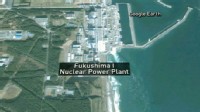28 May 2011
27 May 2011
New leak suspected at crippled Japanese nuclear plant - ABC News
New Leak Suspected at Fukushima Dai-ichi Nuclear Plant

In what may be yet another setback, the operator of Japan's crippled Fukushima Dai-ichi Nuclear Plant says radioactive water may now be leaking from a wastewater storage facility on site.
The Tokyo Electric Power Company, known as TEPCO, told reporters Thursday that nearly 60 tons of radioactive water may have spilled out, raising further concerns about the utility's ability to handle the worst nuclear crises since Chernobyl.
The latest leak was discovered amid efforts to transfer highly contaminated water from the number 2 and number 3 reactors to an improvised storage facility. TEPCO says the water level in the facility had dropped nearly two inches in just 20 hours, suggesting a leak.
The utility has been pumping massive amounts of water in an effort to cool three of Fukushima's reactors, a process TEPCO has said would be completed in three months. Large leaks have already been reported in reactors 1 and 2, and news of this latest leak is yet another setback in the effort to stabilize the reactors.
More than two months after a magnitude 9.0 earthquake and massive tsunami killed about 240,000 people and crippled Fukushima Dai-ichi, TEPCO is struggling to bring the plant under control. Earlier this week, the company said all 3 reactors had gone into a state of "meltdown" within 3 days of the magnitude 9.0 earthquake and the tsunami that followed, confirming what nuclear experts have suspected.
The melted fuel remains covered in water, and temperatures inside the containment vessel are below dangerous levels, officials said. But failure to disclose such information sooner, has outraged critics who say the utility and the Japanese government have responded too slowly.
At a press conference Thursday, Chief Cabinet Secretary Yukio Edano denied accusations of a "cover-up," but admitted the government needed to take seriously "the criticism that we haven't done enough to provide and circulate information."
Environmental group Greenpeace says the radioactive leaks are taking a toll on marine life. New data released by the group shows high levels of contamination in fish, shellfish, and seaweed samples taken 12 miles off the coast of the Fukushima plant.
Analysis by laboratories in France and Belgium found high levels of radioactive iodine and radioactive cesium in seafood, according to Greenpeace. Contamination levels were highest in seaweed samples, which contained radiation 50 times higher than official limits.
"Our data shows that significant amounts of contamination continue to spread over great distances from the Fukushima nuclear plant," said Greenpeace Radiation Expert Jan Van Putte. "Radioactive hazards are not decreasing through dilution or dispersion, but the radioactivity is instead accumulating in marine life."
The International Atomic Energy has launched its own investigation into the nuclear crises. A team of 20 IAEA experts arrived in Tokyo Monday on a fact-finding mission, where they plan to visit the Fukushima plant.
Legacy of Chernobyl: Voices of Pripyat
April 26, 2011...25 years to the day of the accident at Chernobyl
BACKGROUND –––––––––––––––––––––––––––––
In Belarus, where 70% of the fallout from the power plant came, one fifth of the country's agricultural land is contaminated. Food is still tested and will be tested beyond our lifetime.
THE FILM –––––––––––––––––––––––––––––
Japanese scientist: Fukushima meltdown occurred within hours of quake: WaPo
By Brian Vastag and Steve Mufson, Published: May 26
About 11 hours later, all of the uranium fuel in the facility’s unit 1 reactor had slumped to the bottom of its inner containment vessel, boring a hole through a thick steel lining, the University of Tokyo’s Naoto Sekimura told a committee of the National Academy of Sciences.
Is Fukushima now ten Chernobyls into the sea?

(Chernobyl)
Is Fukushima now ten Chernobyls into the sea?
May 26, 2011
26 May 2011
“Situation at Fukushima out of control”: Dr Chris Busby
The situation at the Fukushima plant is currently out of control, says Professor Christopher Busby from the European Committee on Radiation Risks, who gave RT his insight into the recent developments in Japan.
“Of course, it’s time for the Japanese government to take control. But having said that, it’s very hard to know how you could take control of the situation. The situation is essentially out of control,” Busby stressed.
“I believe personally that it’s a global problem – and not the Japanese government’s problem only,” he added.
Earlier on Tuesday, Japan's Prime Minister Naoto Kan said that his government was determined to "take responsibility" for Japan's crippled nuclear plant "right to the end" as the operator of the plant said a revised roadmap to resolve the crisis would stick with the existing timeline.
Speaking to the media on Tuesday, Tokyo Electric Power Co. Vice President Sakae Muto said the operator would maintain the revised plan but will add new tasks, such as boosting preparedness for tsunamis and improving conditions for workers.
Reports say there are signs that two further reactors, Nos. 2 and 3, at Japan's troubled Fukushima plant may have gone into meltdown. Earlier it was confirmed that similar problems had occurred at the number one reactor during the first 16 hours following the plant’s being hit by the earthquake and tsunami.
Are you familiar with the practice known as the stagedrelease of bad news?
Remember what they said at the beginning?
The data now indicate a breach -- let's talk in two months to see who can say "I told you so."
Nuclear Insanity
Global Research, May 25, 2011
Navdanya International - 2011-05-24
The scientific and industrial revolution was based on the idea that nature is dead, and the earth inert matter. The tragedy in Japan is a wakeup call from Mother Nature — an alarm to tell us she is alive and powerful, and that humans are powerless in her path. The ruined harbours, villages and towns, the ships, aeroplanes and cars tossed away by the angry waves as if they were tiny toys are reminders that should correct the assumption that man can dominate over nature — with technology, tools and industrial infrastructure.
Dr Vandana Shiva is the executive director of the Navdanya Trust.
Vandana Shiva is a frequent contributor to Global Research. Global Research Articles by Vandana Shiva
Researchers Find "Stunning" Evidence of Cell Phone Dangers

| By Peter Ferenczi | Tue May 24, 2011 2:45 pm |
These findings were reported in a press release issued by the Environmental Health Trust, which notes that the rat brains can be "used to correspond to the brains of human teenagers."
"This work provides a warning signal to all of us," said Professor Wilhelm Mosgoeller from the Medical University of Vienna. "The evidence justifies precautionary measures to reduce the risks for everyone of us."
Although teenagers do share more than a few qualities with young male rats, rodents remain imperfect models of humans. The other research findings, while potentially interesting, appear to be in-vitro studies of isolated cells. Proving biological effects of radiation on cells is useful in determining the ways radiation might impact humans in the real world, but it does not directly prove much beyond the experimental criteria.
It's unclear whether the research has been published in peer-reviewed journals: if it has not, additional salt must be added to interpreting the findings.
Substantial research into potential health effects of cell phone use on humans has been conducted, and there is no conclusive proof of danger. Some studies have found possible links between phone use and cancer, but the findings are weakened by limitations that make results difficult to interpret. Many studies have found no effects at all. Some, highlighting the difficulties of studying statistically rare events, have even found that phones reduce cancer risk.
A recent study published in the Journal of the American Medical Association found a link between cell phone use and increased glucose metabolism in the brain, which, like other studies finding biological effects, may or may not imply a health effect.
The bottom line is that nobody knows if cells phones are bad for us, but there is always the possibility that they are. Though brain cancer rates are not increasing, it's also true that cancer can take a long time to manifest, and that people are using phones much more intensively now than a decade ago.
The "precautionary principle" suggest that even if chances of negative health effects are low, it makes sense to offset them by avoiding unnecessary exposure to risk. To that end, it can't hurt to use phones with headsets or speakerphone mode whenever convenient.
http://www.mobiledia.com/news/91401.html







